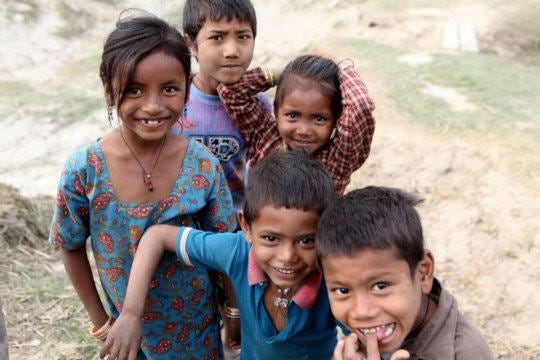Nepal's Health Crisis
Nurturing a Healthier Nepal: Empowering Hygiene and Nutrition through Mindfulness
Imagine if you have a car or motorbike, and are lacking money, would you substitute your fuel for some other, cheaper substitute? No, of course not, because you know the engine would fail. Why, then, do people engage in the same practice with their own most important bodies?
Adding chemicals to crops, or employing harmful things like trans-fat oils while cooking—we know these things are harmful. Yet, at increasing rates people consume items like these out of convenience or to save money. Nutritionists and other scientists have written extensively on the health effects of consuming junk food, or utilizing dangerous chemicals or other substances in cultivating crops or preparing foods.
Still, wandering the aisles of any large grocery store, one can see shelf after shelf filled with non-nutritional food—food the body is not designed to process. The artificial additives in these “foods” create an addiction. They fool the brain into believing that they taste better than traditional, healthy meals. And they are cheaper, and more readily available. Nepal’s population is feeling the effect of their consumption in a tragic, often fatal, way.
Cardiovascular diseases (CVDs) are a major problem in Nepal, contributing to 26.9% of total deaths. From 1990 to 2017, the rates have increased, particularly among males. Among the problems is an acute disparity in health services available to treat CVDs.
While cities tend to contain numerous such facilities, many rural areas possess none, thus requiring patients to travel long distances to obtain care. Curing this issue remains beset with many difficulties, suggesting that the problem will increase before it gets better. The Ministry of Health and Population (MoHP) has instituted a plan to address these concerns, but these things take time, money, and continued commitment. In the meantime, residents of Nepal can adopt their own measures to help mitigate the national problem while enhancing their own health and wellness.
Mitigating Risk
The biggest contributor to CVDs in Nepal is poor nutritional habits or lack of availability of nutritious food. About 72% of the population routinely consumes insufficient amounts of fruits and vegetables. Nepal’s Global Hunger score has improved over the last two decades, but remains only “moderate.” Food access is most limited in the mountainous regions.
Children in Nepal have a particularly low nutrition rate, with just 36% receiving a daily acceptable diet. Agricultural programs, including home and school gardening programs, substantially help to improve eating habits by educating people on more nutritious foods that can be grown within Nepal’s climate.
The MoHP asserts that nutrition programs—teaching people the best foods to eat—comprise among the most cost effective measures to improving overall health throughout the population. It currently runs such a program, though the target audience remains limited to children. School meals programs also vastly improve children’s health, but these programs saw considerable setbacks as a result of the COVID pandemic, according to the World Food Programme. Nutrition education remains a fundamentally important objective.
Photos by Khem Lakai
The other major risk factor for CVDs, hypertension—otherwise known as high blood pressure—is directly affected by diet. Hypertension affects 25% of the population here. It is a serious condition, especially when left untreated—and according to the World Health Organization (WHO), less than 5% of Nepali patients have the condition under control.
Hypertension is primarily caused or exacerbated by smoking, failing to exercise, and eating poorly. Nepal’s smoking rate remains relatively high (24.1%) in comparison to other middle income countries, but especially among males. Smoking is itself also a significant cardiac health risk factor.
Obesity and elevated blood sugar also cause hypertension and lead to increased CVDs risk. Roughly 25% of the population suffers from one or both afflictions. Therefore, following a proper diet and exercise regime (and lowering smoking rates) provides an extremely important avenue toward reducing the three biggest causes of CVDs in Nepal.
Improving the overall daily nutrition for people in Nepal is not an impossible task. One-quarter to one-third of Nepal’s GDP comes from agriculture, thereby indicating that the problem lies in the content of production and less so in the capability.
Nepal’s environment is particularly suited to grow a variety of fruits and vegetables much needed by the population. These include grapes, figs, pomegranates, dragon fruit, bananas, peaches, plumbs, passion fruit, cherry tomatoes, asparagus, Brussels sprouts, and celery, among others. Contrast that with the current highest agricultural outputs: rice, maize, wheat, millet, barley, pulses, oilseeds, and sugarcane.
Cultivating the more beneficial products demands both educating on how to do so, and motivating farmers to comply. For education, more on that is proposed below. On the latter, this will require a substantial shift in the perception of the population about what specific foods people should make sure to ingest—a product of increased education—and ensuring the availability of these items where they are currently lacking. An increased intake of fruits and vegetables among the population, for instance, will increase market demand, thereby creating greater incentive for farmers to grow these items. It would also be beneficial for the government to consider implementing its own incentive program.
Instilling better eating habits is currently facing the obstacle of a rapid increase in the growth of fast-food in Nepal. ‘Junk food’ (another name for fast-food) is called that because it typically contains high levels of calories from sugar or fat, and relatively low levels of nutritious elements, such as fiber, protein, vitamins, or minerals. A study published in 2017 revealed that adolescent students in Nepal preferred junk food at a whopping rate of 90%, despite more than half admitting they knew of the harmful effects of relying on a diet primarily consisting of such food.
Students in urban areas are especially prone to an over-indulgence of fast food. By simple observation, Kathmandu has clearly seen a rise in fast food outlets since the publication of that study six years ago suggesting that the situation has only worsened. Combining the urban junk food problem with the under-nutrition issues in the countryside, Nepal’s national health faces a considerable crisis.
Education
Some organizations already operate in Nepal with a mind toward providing nutrition education. Aasaman Nepal (ASN), for example, provides training on proper eating and nutrition in around 14 districts, primarily in the southern region. Another, the Integrated Nutrition Project (Suaahara), received $46 million from USAID and other stakeholders, but it seems to have concluded in or around 2021 after just 5 years of operation. The MoHP’s nutrition program continues to operate, but at an apparently diminished capacity since COVID. Unfortunately, most programs seem to have limited lifespans and do not remain ongoing.
Moreover, these programs tend to target children—an important demographic given children are the largest, and most undernourished, proportion of the population—but ignore people in middle to late adulthood. Among all the programs, organized dialogue to promote collaborative up-scaling remains elusive. Currently, nutritional education continues to fall within the purview of local organizers, creating a disparity in its efficacy at the national level and perhaps failing to reach some communities altogether.
As the fast-food epidemic shows, education must focus on all areas of Nepal. In the rural parts, educators should focus upon choices of cultivation based on the peculiarities of the climate and landscape in each place. For those regions, nutrition-based decision-making depends very much on the availability of nutritious choices. Therefore, educational efforts need to target growers and providers first.
In the cityscapes, many people enjoy an abundance of choices. For them, educators must target daily habits and awareness. Factors related to price or ‘convenience’ impose significant obstacles as the 2017 study cited above indicates. Educators must prioritize preparation of healthy food as well as good decision-making to overcome people’s generally tendency to select the quickest, most convenient—and unhealthiest—options.
In the Sustainability series, we discussed the importance of including local stakeholders in initiating sustainable practices in tourism, hospitality, education, and agriculture. Sustainability in health includes every person in Nepal, thus the entire national citizenship qualifies as stakeholders.
Connectivity in Nepal has reached levels never before seen in its history. This suggests that incorporating a national program toward educating on proper nutritional practice can be accomplished. The MoHP has laid out a framework in its Muli-Sector Nutrition Plan II, but implementation relies on specific sectors. Therefore, it is imperative to turn an eye toward a nationwide nutrition and general wellness educational program.
Hygienics
Related to nutrition is maintaining proper hygiene in food storage, preparation, and service. The Nepal Government’s 15th Plan elucidates the importance of food and nutrition security, noting “Effective implementation of appropriate strategies and Working policies is essential to achieve food and nutrition security.”
While it has seen improvement over the last few years, Nepal continues to grapple with food and water borne illnesses, especially in the monsoon season. Cholera, dysentery, typhoid, and hepatitis A and E tend to occur in areas rife with contaminated water. People typically ingest pathogens directly through drinking contaminated water, or by eating foods prepared with contaminated water. During the monsoon season, the chances of contaminated water from farm fields or sewage overflow reaching food and drinking sources dramatically increase, leading to seasonal rises in the rates of such illnesses.
The 15th Plan further states, “lack of effective coordination and collaboration among stakeholders caused by weak policies has been a problem in this sector.” This has led to “[u]ncontrolled use of pesticides, antibiotics, hormones, and adulteration in agricultural products from some commercial pocket areas,” which diminish the safety and nutritional value of food items. While resolving these issues ultimately lies at the policy level, education in the affect of using these types of contaminants would vastly reduce their negative effects.
Photo by Khem Lakai
GATE College in Mandikhatar is one among several institutions that have been providing training on basic food hygiene in coordination with the government. GATE follows the principles of One Health (OH), which is a concept developed by the World Health Organization (WHO) and the World Organization for Animal Health (OIE).
Since 2012, the National Zoonoses and Food Hygiene Research Center has been organizing the One Health Alliance Nepal, which focuses on strengthening disease surveillance as well as food and nutritional security and safety under the OH paradigm. Organizers of the program have implored stakeholders to enhance “intersectoral collaboration,” meaning there remains a need to promote a more centralized program for education on hygiene, just as is needed in education on nutrition.
Nepal is home to a wide range of superfoods spread across the most magnificent geography. It enjoys biodiversity and micro-climate conditions like no other. While the world may classify it as a “developing nation,” it is far from a sorry one. The time is now to come together to protect consumers through tighter food hygiene regulations, traceability, good agricultural practice and, most importantly, nutritional awareness. Implementing these policies will bolster the local economy, tourism, and sustainability and improve the health of the Nepali people. The capital city, among the most resplendent on Earth, can begin this immediately.
***
Thank you to my special guest author Khem Lakai. Mr. Lakai is CEO and Founder of the Global Academy for Tourism and Hospitality Education in Nepal.
I am a Certified Forensic Computer Examiner, Certified Crime Analyst, Certified Fraud Examiner, and Certified Financial Crimes Investigator with a Juris Doctor and a master’s degree in history. I spent 10 years working in the New York State Division of Criminal Justice as Senior Analyst and Investigator. I was a firefighter before I joined law enforcement and now I currently run a non-profit that uses mobile applications and other technologies to create Early Alert Systems for natural disasters for people living in remote or poor areas.
Visit the new Evidence Files Facebook and Medium pages; Like, Follow, Subscribe or Share!
To read more about focusing on educating better choices in health, wellness, and sustainability, click the article below.







Great, insightful and relevant for nice eye opener
Great article